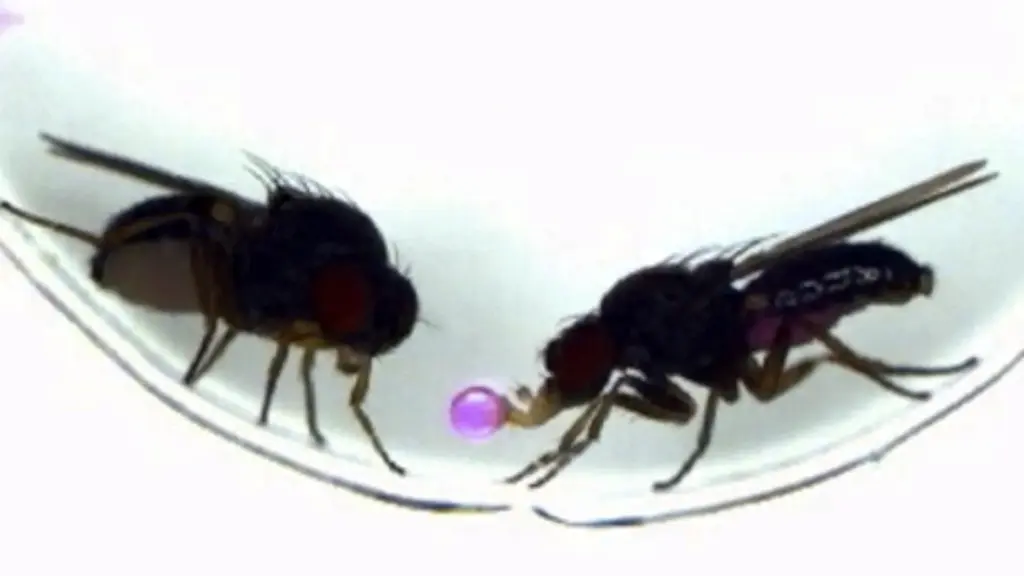
Researchers in Japan have achieved a groundbreaking feat by genetically transferring a unique courtship behavior from one fruit fly species to another. By activating a single gene within insulin-producing neurons, the team successfully induced a species of fruit fly, Drosophila melanogaster, to perform a gift-giving ritual previously unseen in its behavior. This study, published in the journal Science, marks the first instance of manipulating a single gene to forge new neural connections and transfer behavior between species.
In the natural world, male fruit flies typically court potential mates by rapidly vibrating their wings to generate sound patterns, known as “courtship songs.” However, Drosophila subobscura males have evolved a distinctly different strategy: they regurgitate food to present as a gift to females during courtship. This behavior is absent in closely related species like D. melanogaster.
Understanding the Genetic Basis of Courtship Behavior
The divergence between these two fruit fly species occurred approximately 30-35 million years ago. Both species possess a gene called “fruitless” or “fru,” which governs courtship behavior in males. Yet, they employ divergent strategies—one sings while the other offers gifts. Researchers discovered the underlying reason for this difference: in gift-giving flies, insulin-producing neurons are connected to the brain’s courtship control center, whereas, in singing flies, these cells remain unconnected.
“When we activated the fru gene in insulin-producing neurons of singing flies to produce FruM proteins, the cells grew long neural projections and connected to the courtship center in the brain, creating new brain circuits that produce gift-giving behavior in D. melanogaster for the first time,” explained Dr. Ryoya Tanaka, co-lead author and lecturer at Nagoya University’s Graduate School of Science.
The Methodology Behind the Discovery
To achieve this transformation, researchers inserted DNA into D. subobscura embryos to create flies with heat-activated proteins in specific brain cells. By applying heat, they activated groups of these cells, comparing the brains of flies that did and did not regurgitate food. They identified 16-18 insulin-producing neurons that generate the male-specific protein FruM, clustered in a brain region known as the pars intercerebralis.
“Our findings indicate that the evolution of novel behaviors does not necessarily require the emergence of new neurons; instead, small-scale genetic rewiring in a few preexisting neurons can lead to behavioral diversification and, ultimately, contribute to species differentiation,” noted Dr. Yusuke Hara, co-lead author from the National Institute of Information and Communications Technology (NICT).
Implications and Future Research
The study’s implications extend beyond fruit flies, offering insights into how complex behaviors can be traced back to their genetic origins. “We’ve shown how we can trace complex behaviors like nuptial gift-giving back to their genetic roots to understand how evolution creates entirely new strategies that help species survive and reproduce,” stated senior author Dr. Daisuke Yamamoto from NICT.
The research, titled “Cross-species implementation of an innate courtship behavior by manipulation of the sex-determinant gene,” was published in the journal Science on August 14, 2025, under DOI: 10.1126/science.adp5831. It represents a collaborative effort led by Drs. Yusuke Hara and Daisuke Yamamoto at NICT, in partnership with researchers from Nagoya University.
Funding and Support
This research was supported by KAKENHI Grant-in-Aid for Scientific Research, including “Early-Career Scientists” (Project Numbers: 19K16186, 21K15137), “Scientific Research A” (Project Number: 21H04790), “Transformative Research Areas (A): Hierarchical Bio-Navigation Science” (Project Numbers: 22H05650, 24H01433), and “Scientific Research C” (Project Number: 23K05846).
The announcement comes as a significant advancement in understanding genetic influences on behavior, potentially paving the way for further studies into the genetic basis of complex behaviors across species. As researchers continue to unravel the mysteries of genetic influence, the potential for new discoveries remains vast, with implications for evolutionary biology and beyond.




